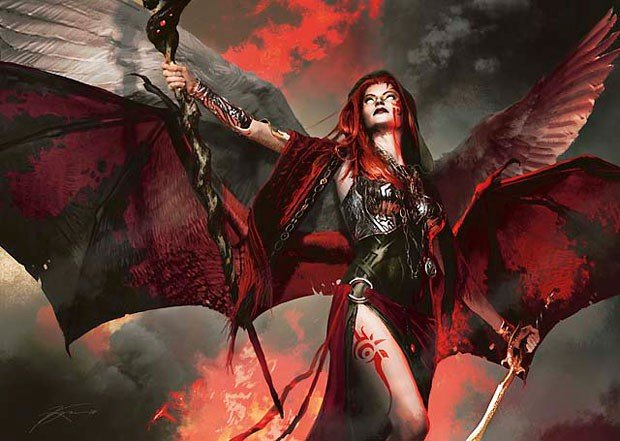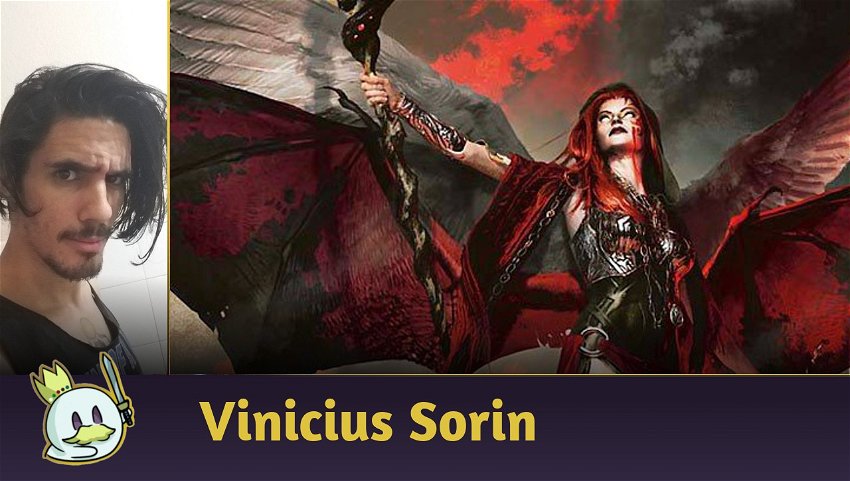From the moment she came into the world in 2011, Kaalia of the Vast has been one of Commander's most iconic generals. It had been designed to be based on a specific deck type, one that brought together all that was best in angels, demons, and dragons. However, this wasn't exactly the approach I chose in 2016 when I decided I wanted to make a deck with this fantastic commander.

Deck's Origins
Around 2014, the idea of a new deck came to my mind. It came from a play I imagined with Repay in Kind, a card I'd had in my collection for a long time but had never found a use for.
Ad
The play consisted of casting the spell when I was down to zero life to eliminate all players. I would be the only exception, obviously, as I would be protected by an effect that prevents me from losing. Phyrexian Unlife was what I had in mind, but I knew there were several other possible options. I wanted to avoid relying on a single card, so I tried to search for other cards that had a similar ability to swap life totals.
I found four of them: Reverse the Sands, Soul Conduit, Magus of the Mirror and Mirror Universe. Except for this last one (which belongs to the infamous Reserved List), all were relatively cheap, and I could easily acquire them, thus confirming what I wanted to know: yes, a life swap deck was possible.

So, I started to think about the support themes because my idea was to build a deck with an unusual game plan, something my playgroup didn't expect at the time. Initially, I decided to saturate the deck with all the best possible ways to avoid defeat: Phyrexian Unlife, Soul Echo, Platinum Angel and Angel's Grace.
Then I chose some cards with useful effects that let me pay life indefinitely, like Necropotence, Hatred and Toxic Deluge, so I could lower it to the amount that was most convenient for me at the time. Other cards could also drain my own life, like Pain Lands, Shock Lands, etc.

Still, all the life swap effects (which until then were the main winconditions) required a lot of mana and most were telegraphed. This made the strategy quite vulnerable. Any removal on Phyrexian Unlife, Platinum Angel or whatever is keeping me alive would make me lose the game, not to mention the counterspells (although Boseiju, Who Shelters All helps a little thereby).
I wasn't happy with that possibility, and I wanted some chance to keep breathing in situations like these; so I decided that the deck should have ways to also reset my life in case things got out of hand. So cards like Worship, Children of Korlis, Tainted Sigil and other instant speed life-gaining effects received their slot.

The main themes of the deck were ready, but something essential was still missing: a commander. By now it was clear that the deck needs to be White and Black. So out of the options available at the time, I decided on Selenia, Dark Angel. She seemed perfect for her ability, with a cost in life points that could be activated indefinitely, serving as one of the possible pieces of the combo. The list I've played for quite a while since then, has been something close to this:
Nowadays, life exchange decks are quite expected for Selenia, but a few years ago it was not so common. I even surprised some friends playing with it, but it wasn't that efficient. The deck was heavy and the conditions for the combo were difficult, although not many pieces were needed. It was still fun for me, as I like different strategies, so I decided not to take it apart.
Ad
However, something has always made me uneasy with this deck. I felt it could gain a lot if it got the addition of red. Some cards made me believe that... Five cards actually: Treasonous Ogre, Fire Covenant, Form of the Dragon and Moltensteel Dragon.
I wanted to have the opportunity to use them in a Life Exchange strategy, so I unpretentiously started researching ways to splash a third color and turn the deck into Mardu. It was perfectly possible and not at all difficult, actually. The biggest problem for me was changing commanders. As much as this was a deck built from the bottom up (when the strategy doesn't develop from the commander, but from interactions of cards that will be among the 99) the idea of replacing Selenia, Dark Angel — a card that plays a really useful role in the game plan — by some random Mardu commander whose only use would be to give me access to colors bothered me a lot.
I didn't want a general who just spruced up the Command Zone; this went against my moral code at EDH. So, I had no choice but to modulate my deck to suit the incoming commander, which could mean adding a sub-theme or two and making it a little more bloated. It would have to make room for cards that would probably be there to give the commander some purpose. It wasn't such a simple decision.
So I started looking for Mardu commanders who would allow me to change as little as possible from the original deck. There weren't many options at the time: we're talking about 2015/16, the Kahns of Tarkir block had already stocked the metagame with a few Mardu commanders, but the overwhelming majority were still almost entirely combat-oriented cards. Alesha, Who Smiles at Death, Zurgo Helmsmasher, Oros, the Avenger, Partner combinations... and Kaalia of the Vast, of course.
Kaalia was the most “fashionable” of them all and was not my first or second option, as her deck was very popular. Everyone does the same because there's really no other way to play with her, other than to gather the best angels, dragons and demons you can in a highly aggressive deck. Some technologies like Kaalia's combinations with Rakdos the Defiler or Master of Cruelties could make the deck more lethal, but still predictable. The high popularity and saturation of this commander made it less interesting to propose a deck that was unusual and different, so it ended up going unnoticed by me initially.
Until I noticed a curious fact: many cards I already used or could use were angels or demons, like Platinum Angel, Resolute Archangel, Exquisite Archangel, Kuro, Pitlord, Bloodgift Demon, Rune-Scarred Demon. It was still a small amount to justify Kaalia of the Vast, but with some adjustments, the deck could take the form where the commander was able to play some role and who knows, even accelerate the deck's main strategy.
I took the idea, made the adaptations and in the end it worked! The deck has become potentially more aggressive, and while it was still a Kaalia of the Vast deck, it is not limited to just the commander's conventional plays as it has the Life Exchange combo. Since then, I've kept it built, and I've been updating it all the time, keeping an eye out for any interesting angels, dragons, or demons that come along. The current list looks like this:
Ad
Concept, Characteristics & Gameplan
Unlife Exchange is a deck with a few different combo lines involving life exchange effects. It uses cards that offer “safeguard against death” (specifically Angel's Grace, Platinum Angel, Phyrexian Unlife and Soul Echo) to allow you to reach 0 or less life points without losing the game to then exchange your life total with other players, making them lose the game.
The 0 life condition can be reached abruptly (thanks to “pay X life” abilities) or on a cadenced basis (as life is lost naturally over the course of the game). In some cases, it is possible to reduce one's life to a low amount but greater than 0, exchange them with another player, and then eliminate them by attacking with a creature, or dealing direct damage with Boros Charm or another card
Examples of Exchange lines:
- Phyrexian Unlife + Necropotence + Repay in Kind = all opponents lose the game.
- Soul Echo + Toxic Deluge + Reverse the Sands = an opponent of your choice loses the game (and you choose the life total that suits you best).
- Angel's Grace + Kuro, Pitlord + Soul Conduit = An opponent of your choice loses the game.
Against counterspells, the deck runs Boseiju, Who Shelters All. There are other lands that require a life payment, so you need to consider them in the calculation when placing the combo (you can't tap a Boseiju to generate mana if you don't have at least 2 life to pay).
As an alternative to these combos, the deck uses the two classic Kaalia of the Vast plays:
- Kaalia of the Vast + Master of Cruelties = if there are no blockers, the defending player loses the game.
- Kaalia of the Vast + Rakdos the Defiler = no drawback for you. Defending player sacrifices half of his permanents.
Both plays only work if the demons are played from the hand with Kaalia's ability. It is possible to repeat the feat by sacrificing the demon with Razaketh, the Foulblooded and returning it from the graveyard with Phyrexian Reclamation.
Another way to eliminate a player with an attack is as follows:
- Kaalia of the Vast + Hatred (paying 19 life) = 21 commander damage to an opponent.
All of these winconditions are slow, requiring some resource management in the early turns of the game. The deck doesn't have enough angels, demons, and dragons to take a proactive stance from the early game as most decks in Kaalia of the Vast do, so the best approach is to use interactions in the first few turns while searching for the combo pieces. Still, the commander can be threatening and put a lot of pressure on opponents while remaining in the game.
However, Kaalia's real function is to speed up your game a little by playing creatures that, in addition to bombs, are useful in the deck, such as Razaketh, the Foulblooded, Doom Whisperer and Vilis, Broker of Blood, in addition to serving as a decoy and diverting your opponents' attention from the real danger of this deck that are Exchange combos.
Ad
Strengths & Weaknesses
The best quality of this deck is undoubtedly its resilience. Although the commander has a forehead target, the deck has tools to minimize the consequences of a massive life loss, even to the point of benefiting from it. Cards like Vilis, Broker of Blood and the life exchange effects themselves discourage your opponents from punishing you with one-off attacks. In addition, the deck depends little on the commander, allowing for a certain tranquility when playing normally not seen in other versions of Kaalia of the Vast.
Its downside is that while it's still possible to surprise unsuspecting opponents, all of your win lines are slow and telegraphed and depend on a high dose of risk. The deck is made to work with critical amounts of life, and an oversight can put you in a very tricky situation. It's not uncommon for you to need to keep yourself at 5 or less while looking for a way to win.
Conclusion
I hope you enjoyed my not-so-orthodox version of Kaalia of the Vast. This deck brought me and continues to bring me a lot of joy, and I hope you had fun with this deck tech too.
Thanks for reading and good games!
Any questions, I'm available in the comments!









— Comments0
Be the first to comment